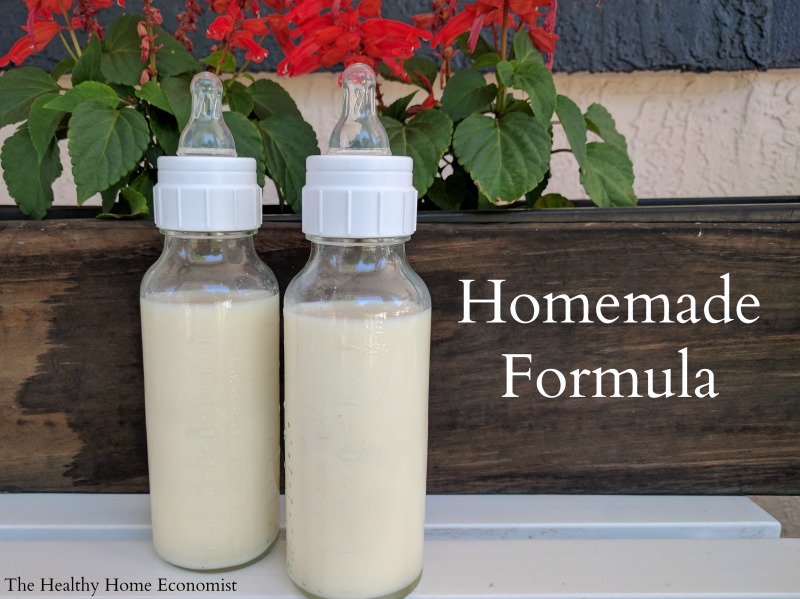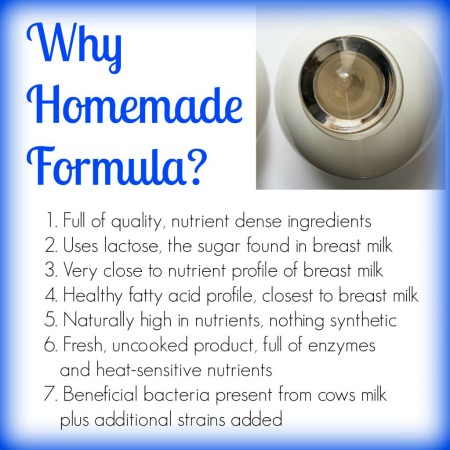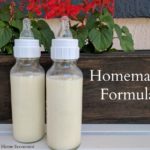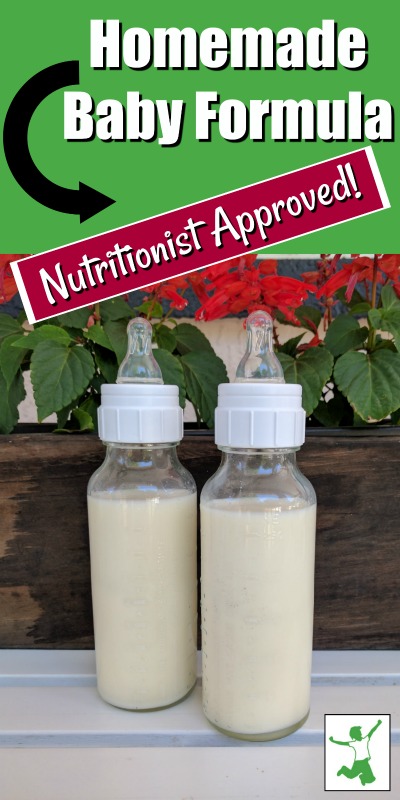Table of Contents[Hide][Show]
A nourishing homemade baby formula using safe, whole ingredients. This recipe was developed and tested by Dr. Mary Enig, a PhD Nutritionist and originally published in Nourishing Traditions cookbook in 1996. It was formulated to match breastmilk as closely as possible and is also suitable for infants. Source: Weston A. Price Foundation

There is no doubt that breastfeeding your baby is the best option for the child’s long-term health and development. Human breastmilk from a well-nourished mother is the perfect food for baby. However, in circumstances where the child is adopted or the Mother finds herself unable to breastfeed, formula feeding becomes necessary. In those cases, homemade baby formula is best.
Using a baby formula recipe that closely matches the nutritional profile of breastmilk is a far better choice than even organic baby formula from the health food store. More on this below.
Note: Donor programs are widely available for human breastmilk. But, the diets of the donor mothers are unknown and most likely nutritionally insufficient. In addition, breastmilk banks pasteurize the donated breastmilk which destroys much of the nutritional benefit. Unless you are fortunate to have a trusted and direct donor milk source in your community, avoid this option!
Dangers of Commercial Formula
Commercial formulas are always a poor choice for a number of reasons. First of all, formula manufacturers line the cans with the chemical BPA. This substance disrupts hormone development and is a probable contributor to early puberty in girls, and ADHD, urogenital abnormalities, and other ills in boys.
The European Food Safety Authority found that canned commercial formula is a significant source of BPA for infants, exposing the child to 13mcg of BPA per kg of body weight per day! BPA-free formula cans are no better. The chemical BPS is typically used instead which is just as dangerous.
Beware that manufacturers pack even organic commercial formula like Earth’s Best in BPA cans. Worse, they use organic brown rice syrup as the primary sweetener which is known to be frequently contaminated with arsenic.
In addition, all commercial milk formulas are processed at extremely high temperatures which violently denature the fragile milk proteins, render them allergenic, and add carcinogens to the final product. Soy infant formula is the worst. Obscenely high processing temperatures not only denature the proteins but large levels of phytic acid in soy block mineral absorption by the infant. Moreover, soy-based plant estrogens disrupt the hormonal development of the baby!
It seems that for the concerned Mother who is unable to breastfeed, learning how to make baby formula at home with safe, pure ingredients is the most prudent way to go!
Why Make Homemade Formula Even if You Are Breastfeeding
In the video below, I show you how to make your own safe, healthy raw milk homemade formula for your baby.
The recipe I follow was originally published in the cookbook Nourishing Traditions in 1996 and developed by Dr. Mary Enig.
Even though I breastfed each of my children for at least 2 years, I made this exact formula for my own children when I was away for the day or the evening as pumping was not an option that worked well for me.
I even used this homemade formula for an entire day once when I had some dental work done and was advised to pump and discard for 24 hours.
As a result, even successfully breastfeeding Moms can use this wonderful homemade formula as a supplement when necessary to their own nutrient-dense breastmilk!
It is advised that even breastfeeding Mothers have the ingredients for this formula on hand for an emergency. If Mom is sick or otherwise unable to nurse, Dad can step in and make this safe alternative until Mom is back on her feet. It takes a few days to a week to gather all the ingredients together to make this formula, which is why I advise having them on hand at all times.
Homemade Most Nutritious
The image below lists the reasons why it is worth it nutritionally to make formula yourself for your precious baby!
You can order all of the required ingredients for the homemade baby formula in one package from this reputable, vetted source.
Moms who have successfully used this formula feeding your children, please post about your experience in the comments section to encourage those who are considering it and need some Mom to Mom encouragement!

Where to Source Quality Milk
The most widely available grass-fed milk around the world is from cows. This is usually the most budget-friendly and easily sourced milk for this recipe for homemade formula.
If only goat milk is available in your area, this recipe for goat milk baby formula can be used instead. When using milk from ewes, please refer to the linked article for an adjusted recipe; one of the benefits of sheep milk is that it is higher in healthy fats than either goat or cow milk.
Camel milk formula is another option that is a particularly digestible form of dairy and growing in popularity around the world.
Alternatively, you can use low temp (vat) pasteurized, non-homogenized whole milk cultured with a piima or kefir starter. Then substitute the piima milk or kefir for the raw milk portion of the formula recipe. Cold-pressed raw milk also must be cultured before using it as it contains no probiotics.
Do NOT use ultrapasteurized (UHT) milk even if organic as it is too highly processed and extremely allergenic!
It is also best to avoid all types of powdered milk for this recipe. The factory process of making milk powder reduces nutrition considerably and denatures it, which makes it more likely baby will have an allergic reaction.
Dairy Allergy Option
If all types of dairy prove unsuitable for your baby, make this nondairy baby formula recipe instead. It uses a base of homemade bone broth as a substitute for milk. It is important not to utilize a plant-based or otherwise vegan baby formula recipe.
Avoid buying bone broth to make the dairy-free formula. Make it yourself! Manufacturers of commercial bone broth, even if authentic, may water down the end product. This is apparent if it does not gel when chilled in the refrigerator.
Many brands have toxic packaging issues as well. If you must buy it in a pinch, see my shopping guide page for vetted brands that are safe.

Homemade Baby Formula Recipe (for infants too)
A nourishing baby formula recipe you can make at home with safe, whole ingredients developed and tested by a PhD nutritionist to match breastmilk as closely as possible. Also suitable for infants.
Ingredients
- 2 cups raw cow milk OR organic whole milk yogurt
- 1 7/8 cups filtered water
- 1/4 cup liquid whey
- 4 Tbl lactose
- 1/4 tsp Bifidobacterium infantis powder
- 2-4 Tbl raw or pasteurized cream
- 1/2 tsp cod liver oil unflavored
- 1/4 tsp butter oil unflavored
- 1 tsp sunflower oil preferably organic
- 1 tsp extra virgin olive oil preferably organic
- 2 tsp virgin coconut oil preferably organic
- 2 tsp nutritional yeast
- 2 tsp gelatin
- 1/4 tsp acerola powder
Instructions
-
Fill a 2 cup Pyrex measuring cup with filtered water and remove 2 TBL (this will give you 1 7/8 cup water).
-
Pour about half the water into a pan and turn burner on medium.
-
Add the gelatin and lactose and let dissolve, stirring occasionally.
-
When gelatin and lactose are dissolved, remove pan from heat and add the rest of the water to cool.
-
Stir in the coconut oil and butter oil until melted.
-
Put remaining ingredients in a glass blender.
-
Add the water mixture and blend for about 3 seconds.
-
Place formula in glass baby bottles or a glass jar and refrigerate.
-
Before giving to baby, warm glass bottle in a pan of hot water or a bottle warmer. NEVER microwave baby bottles!
Recipe Video
Recipe Notes
If using raw cow milk from holstein cows, use 4 Tbl of extra cream (otherwise use 2 Tbl extra cream).
If choosing to make this homemade formula with camel milk, be sure to include 4 Tbl extra cream as camel milk is lower in cream than cow milk.
Do not use high oleic sunflower oil. Use only the brand recommended in the ingredients list which is cold pressed, organic, unrefined, and low oleic.
*Do NOT use powdered whey from the store as it is denatured. Avoid whey from making cheese as it will curdle the formula.
*Do not substitute pasteurized or powdered milk as these are heavily processed, denatured and allergenic foods.
*Do NOT use ultrapasteurized (UHT) cream. It is highly allergenic. Raw or pasteurized cream is acceptable.
*Do NOT use fish oil or krill oil instead of high vitamin cod liver oil as they do not contain any Vitamin D and very little to no Vitamin A.
Collagen powder may be substituted for the gelatin in a pinch (more on peptides in baby formula in this article).
If you are wondering where is the iron in homemade baby formula, this article provides an explanation.
If baby experiences constipation using this formula, try adding 1 tsp of molasses to each batch. This should help move things along.
How to Transition to DIY Formula
Once you’ve viewed the video, gathered the ingredients, and made your first batch, how do you feed it to your baby for the first time?
It is important not to switch all at once as this can cause gas, excessive spit-up, or an uncomfortable change in diaper habits such as constipation or overly loose stools.
Start by giving your baby three-quarters of the old formula blended with one-quarter of the homemade. Try this ratio for a day or two and see how your infant responds.
If no digestive upset or major change in diaper habits occurs, increase the amount to a 50-50 blend of old formula to homemade. Observe for another day or two as before.
If no major issues, increase once again to three-quarters homemade formula to one-quarter old formula. If baby does well on this blend for a third time, you are ready to fully transition to the homemade formula.
At any time during the transition, symptoms of intolerance emerge, back up to the previous successful blend ratio and stay there for a day or two before attempting to increase once again.
Homemade Formula FAQ
Weston Price Foundation
Feeding an Adopted Baby
Traveling Tips with Baby Formula Made at Home
Iron in Baby Formula
Collagen Peptides instead of Gelatin for Homemade Formula?










Thank you for this recipe! I’m still breastfeeding/pumping as much as I can, so I would only be using this homemade formula to the odd feed during the week when I’m at work. Do you think I could make a half recipe? Or would it be easier to make the full recipe and keep it in the fridge/freezer? How long will it last in the fridge?
I’ve been trying to find raw cow’s milk in Canada. I’ve read that it’s illegal to sell in Canada and that all milk products need to be pasteurized here – is that true? If not, do you know of any suppliers for raw milk in Vancouver BC?
hello i am from uk and i want to feed my baby with this recipe but now i am looking to by this ingredients in uk and cant find a bovine Gelatin maybe you can send me what different one i can use with picture and name , thank you 🙂
Sources that ship to the UK are provided in the post via links.
How soon can the baby formula kit be shipped and delivered? Is it best to purchase it from your site or the Weston A. Price site. Or is it cheaper to go out and purchase the products myself. Thank you so much!
If you click through to the baby formula kit, it is sold by Radiant Life, not the Weston Price Foundation. You will have to ask them how quickly they ship, but I believe it is same day.
My baby is intolerant to whey. Is there a substitute to the whey? She takes the homemade milk firmula good without they whey but seems like she is not getting enough of what she needs. Please help if have any info.
How do you know she is intolerant to the whey? If she can handle the milk, she should easily handle the whey which is just the clear portion of it.
I prepared all of the ingredients except the whey to begin with bwcause i had only kefir and it required to set a couple of days. I fed her the formula without the whey and she took it fine. However when the whey was ready a couple of days later i added it in and she was terribly fussy as it was hurting her stomach. I left it out of the batch the next day and she took it fine. She was the same way on the store bought formula , earths best i was giving her as it seemed to hurt her stomach. She would cry while giving her the bottle and squirm like she wanted it but hurt as she was taking it. Is there any replacement for the whey i can give her for he whey protein. I dont know if the whey is a longer chain protein that she cannot break down rather the the protein only thats in the milk.?
Try reducing the amount and see if that helps. If she absolutely must have the formula without any whey, that will work, but hopefully she can tolerate at least some even if it is less.
Where I live I can’t get anything but ultra pasteurized cream, is there a substitute or what can I do? Thanks
Yes this is my dilemma as well.I only have ultrapasteurized cream available where I live. Please advise.
Hey ladies – this was and still is a big issue for us as well! When u can find raw or low temp pasteurized cream (we have relatives who bring it up to us from FL when they visit) – but as much as u can and freeze in ice trays to have on hand. Also check any local farms or food coops in your area that might at least have some or be able to provide u with some contacts. But don’t be too worried about not always being able to use the cream…I would say if anything try to always make sure u have the whey to add. That protein is super important. And helps sustain the child like the cream does. That’s just my advice! My son gets both in his formula some days and then only whey added on others. Obviously you do the best u can with what u can!
I am more on bottle feeding my DD because of the nutrition but it will cause my DD constipated. Thanks to my sister recommended Mamil to me and currently feeding my DD with Mamil because of the DHA level is high and also another ingredient named prebiotic are effectively in preventing constipation. It only took me one week to see the result. No more hard stool and I find that she has no more constipation in this few months. I am happy with that.
I am wondering why you say the diet of breastmilk donors is “most likely nutritionally inadequate”. As a previous donor I would say this statement is incorrect. To become a breastmilk donor you must undergo a somewhat rigorous screening process that involves multiple steps to ensure you are a safe and healthy donor, including blood work. The process involves them being in contact with your physicians and pediatrician aswell. Not just anyone can donate human breastmilk.
Absolutely anyone can donate breastmilk. Just check out the breastmilk swapping sites on the internet which is where most women get donor milk.
I do believe that the mom, Ashley was referring to donating breastmilk to breastmilk banks that is bought by hospitals for NICU babies. She is correct in the fact that the process is highly regulated and they do blood work. They also separate milk from dairy eating moms, vegan, vegetairian, and non dairy eating moms. I wouldnt want to get milk from some Internet sight if I did need it. I would ask my lactation consultant about buying it through a milk bank or hospital.
Even if the donor milk is tested for pathogens, these Moms are probably not eating a good diet. Certainly, nearly all of them would not be eating a traditional diet that would be high in healthy (saturated) fats which is what is critically necessary for quality breastmilk. Breastmilk banks also usually pasteurize the breast milk too … destroying much of the benefits. I would only use donor milk from a Mom or group of Moms I personally knew and was familiar with EXACTLY what they were eating and what medications they were taking (none is the only acceptable answer) and did she drink coffee etc etc.
Thanks for this awesome resource.
For those who do not have access to ALL of these ingredients, is there a bare minimum list of ingredients from this one one could use for homemade formula?
I mean what could a baby thrive on, as a healthy alternative to store-bought formula?
And what if grass fed, non-homogenized milk is available, but it’s pasteurized? Is that ok?
Thanks!
The resource linked in the article ships the ingredients all over the world so no need to leave anything out. If you have pasteurized nonhomogenized only … please culture it into kefir or piima as instructed in the article and use that to substitute the milk portion of the milk in the recipe. You can get kefir or piima cultures at culturesforhealth.com
Hi Sarah,
I cultured pasteurized non-homogenized milk and baby has been taking it pretty well. But I’m going crazy not knowing if it’s curdling when I warn each bottle up? I’m warming yogurt up basically…so how do I know I’m not feeding my baby something slightly…ruined?
Thanks!
great article
Hi Sarah,
My son is almost 10 months old, and is allergic to multiple things. I am wondering if I would be able to switch him to only raw milk, and add the other foods into his diet seperately? I am just concerned that it would be harder to distinguish his allergy if everything was in there at once. I am trying to relactate (I couldn’t feed him before without him breaking out and being so miserable) But have not officially gotten any milk yet.